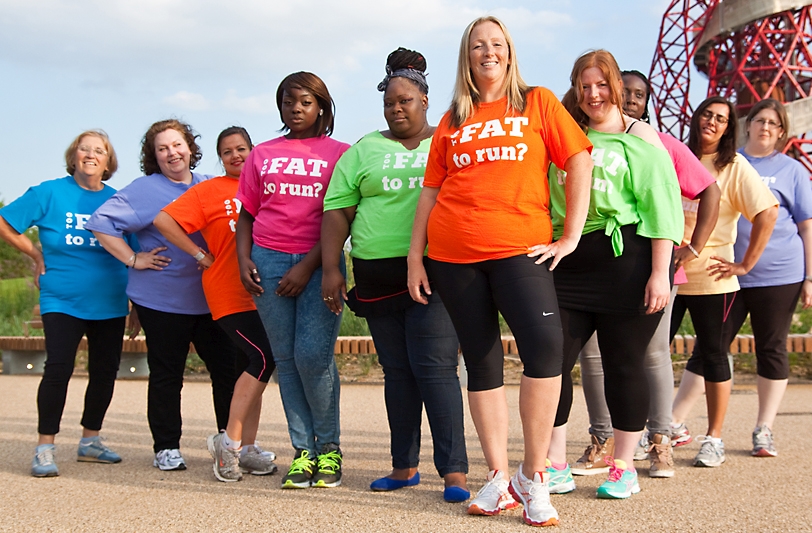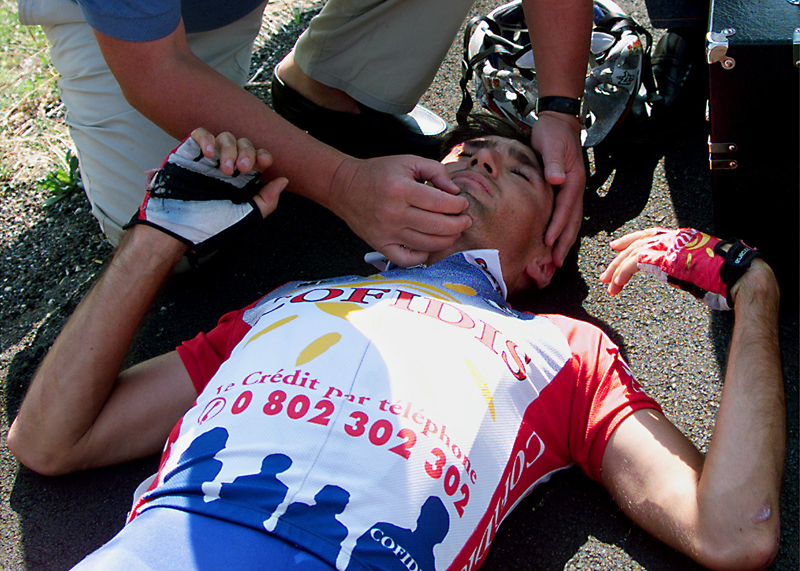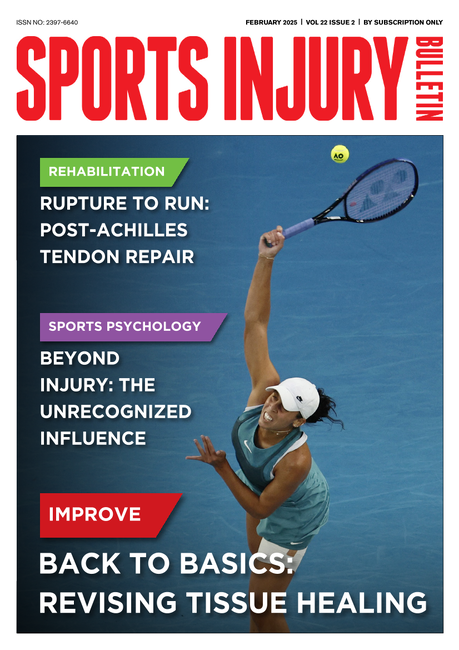Obesity is associated with increased risk of cardiovascular disease(1), type 2 diabetes(2) and certain cancers(3). However, the risks of chronic diseases are lower in those who are fat and fit than those who are fat and unfit(4). Gary O’Donovan’s research at the University of Exeter has investigated why the risks of chronic diseases are lower in the ‘fat-fit’ and this article summarises the tests conducted, the results found, and the implications for athletes of all shapes and sizes.
Our research
We calculated that we needed to recruit around 60 men who were slim and fit, around 20 men who were slim and unfit, around 20 men who were fat and fit, and around 20 men who were fat and unfit in order to have a good chance of detecting meaningful differences in cholesterol concentrations and other important risk factors for cardiovascular disease and type 2 diabetes.Waist girth was measured at the narrowest part between the bottom of the ribs and the top of the hips; values of 90cm or less were used to identify ‘slim’ men and values of 100cm or more were used to identify ‘fat’ men. Maximal oxygen consumption (VO2max) was assessed while cycling: ‘fit’ men scored above average and ‘unfit’ men scored average or below in relation to age-specific norms(5).
We only included unfit men who reported no regular moderate- or vigorous-intensity activity in the last two years and fit men who reported taking part in at least 60 minutes of vigorous-intensity aerobic activity per week in the last two years, which is the minimum amount recommended to develop and maintain aerobic fitness(6). Moderate-intensity activities are those around four metabolic equivalent tasks (METs), such as brisk walking, and vigorous-intensity activities are those of six METs or more (such as jogging), where one MET is equivalent to the energy expended at rest.
Blood tests and body composition
Participants were asked to provide fasting blood samples on two occasions separated by 3-10 days. High-density lipoprotein cholesterol (HDL-C) was measured because HDL-C reduces cardiovascular disease risk(7). Insulin resistance was estimated(8) because it can lead to type-2 diabetes(9). Alanine aminotransferase (ALT) was measured because ALT is a marker of liver damage that is associated with non-alcoholic fatty liver disease and type 2 diabetes(10).Fifty men volunteered to take part in MRI scans to assess total and regional fat distribution. The men were scanned from their fingertips to their toes and fat in the abdominal region was divided into subcutaneous or visceral depots. Subcutaneous fat is that below the skin and visceral fat is that around the organs in the abdominal cavity. There is growing evidence that visceral fat and liver fat are associated with type 2 diabetes and cardiovascular disease(11,12).
Results
Fatness, fitness and activity – Table 1 (below) shows the characteristics of the slim-fit, slim-unfit, fat-fit and fat-unfit groups. Participants were aged 34-53 years. Waist girth ranged from 67-90cm in the slim-fit and the slim-unfit and the average values were not significantly different. Waist girth was significantly higher in the fat-fit and the fat-unfit, ranging from 100-129cm. VO2max ranged from 3.1-5.5 litres/min in the slim-fit and from 3.1-5.3 litres/min in the fat-fit (the average VO2max in untrained 40-year-old men is 2.7-3.2 litres/min). VO2max was significantly lower in the slim-unfit and the fat-unfit. Exercise history ranged from 3-39 years in fit men and the average values were not significantly different. Fit men took part in aerobic exercise or a mixture of aerobic and resistance exercises.Blood tests and body composition – Figure 1 (below) shows that HDL-C was significantly lower in the fat-unfit than the other groups. It also shows that, compared to slim subjects, insulin resistance and ALT were higher in the fat-fit and higher still in the fat-unfit. We used a statistical technique called multiple linear regression to investigate if simple measures of fatness (waist girth), fitness (VO2max) and activity (years of exercise) were associated with HDL-C, insulin resistance and ALT. Waist girth and years of exercise explained 14% of the variance in HDL-C (which means that other factors explained most of the variance). Waist girth and VO2max explained 28% of the variance in insulin resistance. Waist girth alone explained 11% of the variance in ALT.
Figure 2 shows the MRI data. Total fat ranged from 9-25 litres in the slim-fit and the slim-unfit and the average values were not significantly different. Total fat was significantly higher in fat men, ranging from 26-68 litres in the fat-fit and from 28-52 litres in the fat-unfit. The amount of visceral fat was not significantly different in the slim-fit and the slim-unfit, but was higher in the fat-fit, and higher still in the fat-unfit. The amount of liver fat was not significantly different in the slim-fit, slim-unfit and fat-fit, but was higher in the fat-unfit. In multiple linear regression models, waist girth and years of exercise explained 84% of the variance in total fat, waist girth and VO2max explained 70% of the variance in visceral fat, and waist girth alone explained 25% of the variance in liver fat.
Figure 1: Average values of HDL-cholesterol (A), insulin resistance (B) and ALT (C) in 58 slim-fit men, 26 slim-unfit men, 38 fat-fit men, and 17 fat-unfit men aged 34–53 years. *Significantly different to slim-fit. †Significantly different to slim-unfit. ‡Significantly different to fat-fit.
Figure 2: Average values of total fat (A), visceral fat (B) and liver fat (C) in 13 slim-fit men, 12 slim-unfit men, 13 fat-fit men, and 12 fat-unfit men aged 34–56 years. Total fat and visceral fat are expressed in litres and liver fat is expressed as the geometric mean. *Significantly different to slim-fit after adjustment for age and height. †Significantly different to slim-unfit after adjustment for age and height. ‡Significantly different to fat-fit after adjustment for age and height. Data from O’Donovan and colleagues.
Interpreting the findings
It is important to explain how it is possible to be fat, fit and healthy because weight loss can be difficult to achieve and because carrying more weight can actually be advantageous in certain sports and occupations.Blood tests
It is well documented that exercise training can increase HDL-C(13), but most interventions bring about only small changes. There are at least two reasons why we found greater differences in HDL-C than most studies. First, our research reflects years of exposure to exercise. Most interventions tend to range from about 10-52 weeks in duration and the doses of exercise may not be sufficient to bring about the training adaptations that might improve cholesterol concentrations, such as weight loss, an increase in skeletal muscle capillary density, or an improvement in cholesterol metabolism beyond the ‘last bout effect’ (every bout of exercise can increase the activity of enzymes involved in cholesterol metabolism for around 24 hours). Veteran athletes have been exposed to years of exercise and it is interesting that cholesterol concentrations are better in veteran athletes than lean older adults and overweight and obese older adults(14-16).Second, it is possible that exercise is more effective in maintaining ‘desirable’ cholesterol levels than in improving ‘undesirable’ cholesterol levels. For example, an increase in fitness was associated with an increase in HDL-C and a decrease in the ratio of total cholesterol to HDL-C (TC/HDL-C) independent of changes in weight and smoking habits in a study of 753 middle-aged men who attended two medical examinations over 0.5–3.5 years(17). However, a later report showed that perennial exercisers had a better cardiovascular disease risk factor profile at baseline than men who became more active and men who became less active. It also found that perennial exercisers enjoyed improvements in HDL-C, TC/HDL-C and triglycerides over one year(18).
It is encouraging that insulin resistance was lower in the fat-fit than the fat-unfit because insulin plays an integral role in glucose metabolism. Insulin lowers blood sugar levels by binding to and activating insulin receptors in cells, facilitating the transport of glucose into cells, where it can be utilised for energy or stored for later use in the form of glycogen. The available evidence suggests that high-intensity exercise is more effective than moderate-intensity exercise in increasing insulin action(19,20).
Body composition
It is a positive finding that visceral fat and liver fat were lower in the fat-fit than the fat-unfit because regional fat is probably a stronger predictor of chronic disease than general fat(11,12). Subcutaneous abdominal fat may be a ‘protective fat depot’(21,22) and it has been suggested that visceral fat and liver fat may be more likely to accumulate in sedentary individuals whose subcutaneous abdominal fat is unable to act as a ‘metabolic sink’ for the clearance of dietary fat because it has a limited capacity to expand or because it has become insulin resistant(11). It is interesting therefore, that the ratio of visceral fat to subcutaneous abdominal fat was approximately 0.5 in the slim-fit and the fat-fit and it approached 1.0 in the slim-unfit and the fat-unfit (data not shown).Fitness versus fatness
In recent years, scientists have debated whether low fitness or excess body weight is a greater threat to health. The leading expert on the issue, Dr Steven Blair, has suggested that the debate between fitness and fatness is immaterial because physical activity is a treatment for low fitness and excess body weight(23). Blair also suggested that weight loss was the wrong goal because physical activity is beneficial to health whether or not an individual loses weight(24). This is borne out by our research and several randomised trials(25), which suggest that aerobic exercise and the pursuit of physical fitness can reduce visceral fat with or without weight loss.What does this mean for athletes?
What are the implications of these findings for athletes? The most important is that athletes who carry excess weight can still expect to benefit from the protective effects of exercise, since physical activity reduces the risk of chronic disease with or without weight loss. It’s true that the risks of chronic diseases are lower in slim athletes, but fatter athletes will also enjoy reduced risks of type-2 diabetes and cardiovascular disease. This message may be useful for coaches of athletes who pursue excessive weight loss and may be vulnerable to eating disorders.Our findings also suggest that waist girth and aerobic fitness should be measured because waist girth alone cannot distinguish between ‘unhealthy’ visceral adiposity and ‘healthy’ subcutaneous adiposity. In addition, all athletes should endeavour to undertake two or three high-intensity workouts per week, such as sprints, hill runs, or interval sessions on the bike. And for maximum health protection, it is important to try to be active on a daily basis because every bout of aerobic exercise can reduce blood pressure, increase insulin action, and improve cholesterol concentrations for around 24 hours.
Maximising aerobic fitness
There is a genetic component to aerobic fitness, but VO2max is also influenced by exercise frequency, intensity and duration. Dr Robert Hickson and colleagues demonstrated that exercise intensity is the most important training variable in a classic series of experiments in the 1970s and 1980s(26-29). Hickson’s group first showed that VO2max will increase in beginners who train for 40 minutes per day, six days per week as long as exercise intensity is increased on a regular basis(26). They then showed that VO2max could be maintained with only two sessions per week as long as exercise intensity remained high(27) and that VO2max could be maintained when training only 13 or 26 minutes per day as long as exercise intensity remained high(28). Finally, they showed that training adaptations were lost when exercise intensity was decreased(29). Recent studies have confirmed that high-intensity endurance training(30, 31) and interval training(32, 33) are more effective in increasing VO2max than moderate-intensity exercise.Our findings are in keeping with larger studies suggesting that ‘optimal’ BMI is around 23 in young white runners(34) and young white men in the general population(35). Our findings cannot be generalised to women, older adults and other groups but the available evidence suggests that physical activity is beneficial in men and women of all ages and all shapes and sizes. For example, a recent study of more than 250,000 men and women aged 50-71 years found that cardiovascular disease risk and all-cause mortality risk were reduced by around 40% in those who met ‘conventional’ recommendations (at least 30 minutes of moderate-intensity activity on most days of the week), by around 40% in those who met ‘traditional’ recommendations (at least 20 minutes of vigorous-intensity activity three times per week), and by around 50% in those whose activity was equivalent to meeting both recommendations(36). Mortality risk was reduced in various groups who met both physical activity recommendations, including smokers and obese individuals.
Gary O’Donovan is a lecturer in sport and exercise medicine at the University of Exeter. Gary’s research was conducted in collaboration with Edward Kearney from Queen Elizabeth the Queen Mother Hospital in Margate and Louise Thomas and Jimmy Bell from the MRC Clinical Sciences Centre in Hammersmith Hospital.
References
1. Int J Obes (Lond). 2005;29(8):894-902
2. Diabetes Care. 1994;17(9):961-969
3. Lancet Oncol. 2002;3(9):565-574
4. Br J Sports Med. 2009;43(1):49-51
5. Aviat Space Environ Med. 1990;61(1):3-11
6. Med Sci Sports Exerc. 1998;30(6):975-991
7. Circulation. 1989;79(1):8-15
8. Diabetologia. 1985;28(7):412-41
9. Diabetes Care. 1991;14(3):173-19
10. Diabetes. 2004;53(11):2855-286
11. Nature. 2006;444(7121):881-88
12. Int Jl Body Composition Research. 2006;4(1):39-4
13. Arch Intern Med. 2007;167(10):999-100
14. J Gerontol A Biol Sci Med Sci. 2000;55(6):M342-34
15. Aging (Milano). 1997;9(1-2):88-94
16. Am J Cardiol. 1984;54(3):390-393
17. Am J Epidemiol. 1983;118(3):352-359
18. J Clin Epidemiol. 1997;50(10):1137-1142
19. N Engl J Med. 1996;335(18):1357-1362
20. Exerc Sport Sci Rev. 1999;27:1-35
21. Circulation. 2007;116(1):39-48
22. Diabetes Care. 2009;32(6):1068-1075
23. JAMA. 2004;292(10):1232-1234
24. Br J Sports Med. 2009;43(1):1-2
25. Can J Cardiol. 2008;24 Suppl D:25D-31D
26. J Appl Physiol. 1977;42(3):372-376
27. Med Sci Sports Exerc. 1981;13(1):13-16
28. J Appl Physiol. 1982;53(1):225-229
29. J Appl Physiol. 1985;58(2):492-499
30. J Appl Physiol. 2005;98(5):1619-1625
31. N Engl J Med. 2002;347(19):1483-1492
32. J Appl Physiol. 2005;98(6):1985-1990
33. J Physiol. 2006;575(Pt 3):901-911
34. Obesity (Silver Spring). 2009;17(7): 1428-1434
35. Int J Obes (Lond). 2006;30(5):822-829
36. Arch Intern Med. 2007;167(22):2453-2460










